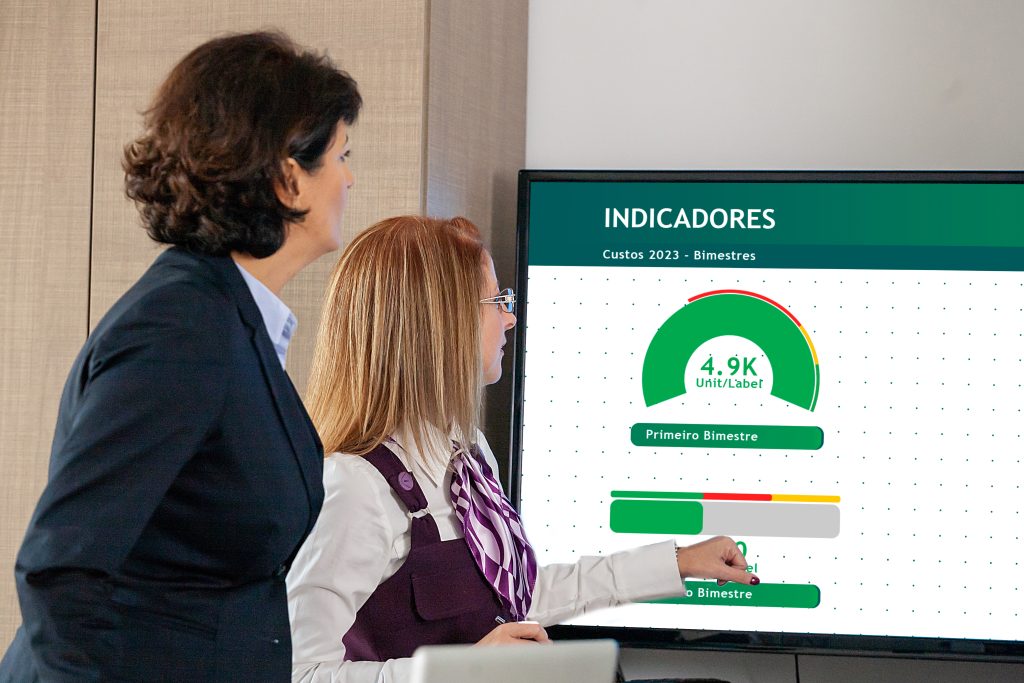
DOOH omnichannel: do ponto físico ao engajamento digital

O que é comunicação interna
Para compreender o que é comunicação interna, é fundamental reconhecer que ela é um pilar para o sucesso de qualquer organização. Claro, ela engloba todas as formas e métodos utilizados por uma empresa para compartilhar informações, ideias, valores e objetivos com seus colaboradores.
Ao promover um ambiente de trabalho transparente e coeso, a comunicação interna fortalece a cultura organizacional, melhora o engajamento dos funcionários e impulsiona a produtividade.
Vamos explorar o conceito de comunicação interna, destacando seus canais, estratégias e a importância de mensurar sua efetividade para alcançar resultados ótimos.
Sumário
Definição e Importância
O que é comunicação interna na prática?
Para responder o que é comunicação interna partimos do seguinte conceito: é um processo estratégico de troca de informações e ideias dentro de uma organização. Visando que todos os membros da empresa estejam alinhados com os valores, metas e procedimentos da mesma.
Uma comunicação interna eficaz melhora a moral da equipe, aumenta a eficiência e facilita a gestão de mudanças.
A importância da comunicação interna
A eficácia da comunicação interna reflete diretamente na performance da empresa, não apenas na melhora da satisfação e retenção dos colaboradores, mas também na construção de uma identidade corporativa sólida.
Uma comunicação interna eficiente garante que todos estejam informados e engajados, o que é crucial para a execução bem-sucedida da estratégia empresarial.
Canais de comunicação interna modernos
Os canais são partes essenciais para compreende o que é comunicação interna na prática. Conheça os que se destacam.
Corporate TV
A Corporate TV é um canal dinâmico que oferece uma forma visual e atraente de comunicar notícias, atualizações e informações importantes aos colaboradores.
Deve ser utilizada em áreas comuns da empresa, como refeitórios e halls de entrada, garantindo que as mensagens alcancem um grande número de funcionários simultaneamente.
Esta ferramenta é campeã para democratizar o acesso à comunicação, uma vez que está disponível para toda a equipe.

Conheça a TV Corporativa B2 Mídia
Uma solução para modernizar sua comunicação interna e aumentar o engajamento da equipe.
Aplicativo de comunicação interna
Aplicativos de comunicação interna são instalados nos celulares dos colaboradores para proporcionar acesso direto e pessoal ao compartilhamento de informações da empresa.
São especialmente úteis para organizações com força de trabalho distribuída, permitindo que todos, independentemente de sua localização, permaneçam conectados e informados.
Intranet
A Intranet é uma rede interna, acessada por meio dos navegadores dos computadores dos colaboradores, que serve como um ponto central de informações para toda a empresa.
Ela facilita a comunicação bidirecional, permitindo não apenas que a gestão compartilhe documentos importantes, políticas e atualizações, mas também que os colaboradores contribuam com feedback e ideias.
Canais de comunicação interna tradicionais
Outros canais de comunicação interna mais tradicionais incluem e-mails, newsletters, quadros de avisos e reuniões regulares.
A escolha dos canais deve basear-se nas necessidades específicas da organização e na preferência de comunicação dos colaboradores.
Estratégias de comunicação interna

As estratégias completam o conceito de o que é comunicação interna na prática. Conheça algumas.
Desenvolvimento de conteúdo relevante
Isso inclui atualizações sobre a empresa, informações sobre bem-estar e desenvolvimento profissional, bem como reconhecimento de realizações dos funcionários.
Promoção da comunicação bidirecional
Encorajar uma comunicação bidirecional é fundamental para uma comunicação interna eficaz.
Isso pode ser feito por meio de pesquisas, aplicativo móvel ou reuniões de feedback, assegurando que os colaboradores se sintam ouvidos e valorizados.
Personalização da comunicação
A personalização da comunicação interna, ajustando as mensagens conforme os diferentes públicos dentro da organização, é crucial para garantir que a informação seja relevante e engajadora para todos os colaboradores.
Como mensurar a comunicação interna

Mensurar a eficácia dos canais de comunicação interna é essencial para avaliar o impacto das estratégias implementadas e identificar melhorias.
Isso pode ser alcançado por meio de softwares específicos que oferecem análises detalhadas sobre o alcance e a interação dos colaboradores com os conteúdos.
Softwares e ferramentas de análise
Existem diversas ferramentas e softwares no mercado que permitem às empresas monitorar e analisar a eficácia da sua comunicação interna.
Estas ferramentas podem fornecer insights valiosos sobre taxas de engajamento, preferências de conteúdo e eficiência dos diferentes canais de comunicação.
Entre as diversas opções disponíveis, o software de comunicação interna da B2 Mídia se destaca como uma solução robusta e integrada, projetada para atender às necessidades específicas das organizações em termos de comunicação e engajamento dos colaboradores.
Esta solução oferece uma plataforma que combina funcionalidades como distribuição de conteúdo, análise de engajamento e comunicação bidirecional, tornando-se uma escolha ideal para empresas que buscam otimizar sua comunicação interna.
Ao implementar o software de comunicação interna da B2 Mídia, as organizações podem esperar uma série de benefícios, incluindo:
- Melhoria no Engajamento dos Colaboradores: Com a distribuição de conteúdo relevante e a promoção da comunicação bidirecional, as empresas podem aumentar significativamente o engajamento e a satisfação dos colaboradores.
- Eficiência na Comunicação: A capacidade de analisar o desempenho de diferentes canais e ajustar as estratégias conforme necessário resulta em uma comunicação mais eficiente e impactante.
- Fortalecimento da Cultura Organizacional: Ao assegurar que todos os colaboradores estejam alinhados com os valores e objetivos da empresa, o software ajuda a construir e manter uma cultura organizacional forte e unificada.
Em resumo, o software de comunicação interna da B2 Mídia oferece uma solução eficaz para organizações que buscam aprimorar sua comunicação interna com excelência.
Por fim
Agora que você descobriu o que é comunicação interna e como ela é um elemento fundamental para o sucesso organizacional, promovendo um ambiente de trabalho informado e colaboradores engajados, pode empregar uma variedade de estratégias focadas e monitoramento contínuo da eficácia
A sua empresa pode assegurar que a comunicação interna impulsione os resultados e promova uma cultura forte.

O que é TV Corporativa
A comunicação interna eficaz é a chave para manter equipes informadas, engajadas e motivadas. Uma ferramenta que vem ganhando destaque nesse cenário é a TV Corporativa.
Bora descobrir o que é TV Corporativa, seus benefícios positivos no ambiente de trabalho, e descobrir as melhores dicas para escolher um fornecedor que te encante.
Sumário
O que é TV Corporativa na prática?
Para entender o que é Corporate TV vamos explicar o seu conceito e objetivo prático, mostrando exemplos reais aqui da B2 Mídia.
TV Corporativa é um sistema de comunicação interna que utiliza conteúdo audiovisual exibido em monitores instalados estrategicamente pela empresa.
Seu objetivo é disseminar informações relevantes, notícias, atualizações e conteúdos motivacionais para os colaboradores, criando um canal direto e eficaz de comunicação.
Impactos Positivos da TV corporativa no Ambiente de Trabalho
Engajamento da Força de Trabalho
A TV Corporativa serve como uma ferramenta vital para engajar os colaboradores, fornecendo-lhes informações atualizadas sobre a empresa, seus objetivos e desempenho.
Ela permite a celebração de conquistas coletivas e individuais, aumentando o senso de pertencimento e motivação entre os membros da equipe.
Redução de Estresse
Em um ambiente de trabalho dinâmico, manter-se informado pode ser uma fonte de estresse.
A TV Corporativa simplifica o fluxo de informações, tornando-o mais acessível e menos sobrecarregado, contribuindo para um ambiente de trabalho mais calmo e produtivo.
Conexão com os Valores da Empresa
Transmitir os valores e a missão da empresa através da TV Corporativa ajuda a reforçar a cultura organizacional.
Assim, todos os membros da equipe estarão alinhados e comprometidos com os mesmos objetivos e princípios.
Aumento da Moral
A exibição de conteúdo motivacional, anúncios de sucesso e reconhecimento de desempenho dos colaboradores por meio da TV Corporativa geram ótimas experiências e elevam a moral da equipe.
Esse reconhecimento e valorização contribuem para um ambiente de trabalho mais positivo e inspirador.
Indicadores Valiosos
A TV Corporativa apresenta indicadores de desempenho valiosos, especialmente em locais estratégicos como fábricas e centros de distribuição.
Esse recurso está intimamente ligado ao conceito de Indústria 4.0, que representa a quarta revolução industrial, focada na automação e troca de dados em processos de manufatura.
Monitores instalados nesses ambientes operacionais exibem conteúdos específicos, como números, gráficos e outros indicadores vitais, permitindo que as equipes acompanhem o desempenho da produção instantaneamente. Isso não apenas facilita a compreensão dos objetivos e metas em tempo real, mas também promove uma cultura de transparência e responsabilidade.

Conheça a TV Corporativa B2 Mídia
Uma solução para modernizar sua comunicação interna e aumentar o engajamento da equipe.
Características Importantes ao Escolher um Fornecedor de TV Corporativa

Interface Simples e Amigável
A plataforma de gestão da TV Corporativa deve ser intuitiva, permitindo que pessoas sem conhecimentos técnicos específicos possam operá-la facilmente, otimizando o tempo e reduzindo a necessidade de treinamentos complexos.
Tecnologia e Qualidade dos Equipamentos
A tecnologia por trás da TV Corporativa deve ser de ponta, garantindo a qualidade da transmissão do conteúdo.
Outro aspecto vital é que os equipamentos utilizados devem ser confiáveis e adequados para evitar que desliguem constantemente ou apresentem problemas técnicos.
Vamos te contar algo bem interessante! A TV Corporativa da B2 Mídia é compatível com os melhores hardwares, sistemas operacionais e monitores profissionais disponíveis no mercado.
Suporte
Escolher um fornecedor de TV Corporativa que ofereça um excelente suporte técnico é crucial. Afinal, problemas e dúvidas podem surgir, e ter um suporte ágil e eficiente garante a continuidade e a eficácia da comunicação
Poucas empresas abordam esse tópico por ser sensível em sua operação, por isso queremos lançar um desafio para você: procure informações comprovadas sobre o suporte que o seu fornecedor oferece.
Como procurar? Avalie com olhar técnico os depoimentos dos clientes, avaliações na internet e solicite resultados de pesquisas NPS, afinal, fornecedores preocupados com o seu suporte aplicam metodologias para mensurar a qualidade, não acha?
A nossa equipe de suporte mantém uma média mensal superior a 85 pontos, comprovando a excelência do suporte B2 Mídia.
Integração com Plataformas e Serviços Externos
Essa funcionalidade permite automatizar a atualização de conteúdos relevantes, garantindo que as informações exibidas nos monitores sejam sempre atuais e precisas.
A integração eficiente com sistemas como Intranets, ERPs (Enterprise Resource Planning), CRMs (Customer Relationship Management), e outros softwares de gestão, transforma a forma como as informações circulam dentro da empresa.
Um exemplo de Integração da TV Corporativa
indicadores de desempenho extraídos diretamente de sistemas de gestão podem ser automaticamente atualizados em tempo real nos monitores da TV Corporativa.
Isso elimina a necessidade de atualizações manuais dos dados, reduzindo a margem de erro e economizando tempo valioso.
Conclusão
Agora você sabe o que é TV Corporativa e seu papel na comunicação interna que, quando implementada corretamente, pode trazer inúmeros benefícios para o ambiente de trabalho. Uma ferramenta que não apenas promove o engajamento e a moral da equipe, mas também contribui para a construção de uma cultura de trabalho forte.
Ao escolher um fornecedor, é fundamental considerar a facilidade de gestão do conteúdo, a usabilidade da interface, o suporte oferecido, além da tecnologia e qualidade dos equipamentos.
Com a seleção correta, a TV Corporativa se tornará um componente integral da estratégia de comunicação interna de qualquer empresa, conduzindo a uma força de trabalho mais informada, motivada e alinhada com os objetivos corporativos.
Continue reading